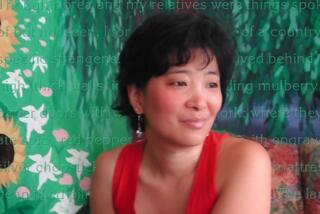Book review: ‘In Other Worlds’ by Margaret Atwood
In Other Worlds
SF and the Human Imagination
Margaret Atwood
Nan A. Talese/Doubleday: 259 pp., $24.95
Great fiction writers are usually better at showing than at telling. Sometimes, though, the job of explaining their creative choices is thrust on them by critics and others contributing to the daily cultural chatter. Canadian novelist Margaret Atwood rises to the challenge in her new book, “In Other Worlds: SF and the Human Imagination,” in which she describes her lifelong relationship with the writerly worlds of fantasy and science fiction.
To call “In Other Worlds” a defense of science fiction isn’t accurate. Yes, there is a thread of self-justification here. She does address how a serious novelist with a worldwide reputation would spend her time in genres regarded by the monolithic, anonymous literati as shallow and escapist. In her words:
“Why did I jump the tracks, as it were, from realistic novels to dystopias? Was I slumming, as some ‘literary’ writers are accused of doing when they write science fiction or detective stories?” asks the Toronto-based author in her essay “Dire Cartographies.”
And she also includes, in an appendix, her letter to a school district board in San Antonio after it banned her novel “The Handmaid’s Tale” (a decision since reversed) for its strong sexual content. “I would like to thank those who have dedicated themselves so energetically to the banning of my novel,” she begins. “It’s encouraging to know that the written word is still taken so seriously.”
In between these statements, however, there is much more in “In Other Worlds” that showshow science fiction fits into a long, venerable tradition.
Atwood gives us a bracing tour of the writers and books she admires (like Ursula Le Guin, and “She” by H. Rider Haggard), her interest in ustopia (a mix of utopia and dystopia) in her fiction, as well as some autobiography. (As a child, she explains early on, “I wasn’t much interested in ‘Dick and Jane’… Several-headed man-eating marine life seemed more likely to me, somehow, than Spot and Puff.”)
In “Of the Madness of Mad Scientists,” she finds a surprising link between literature’s Faustian magicians and the mad scientists of B movies: “I propose Jonathan Swift, acting in synergy with the Royal Society,” and she goes on to give an engaging reading of “Gulliver’s Travels” and the world created by its author.
If you’re like me and have never read Bryher’s “Visa for Avalon,” Atwood will make you want to; and she’ll send you back to other books, like “She,” by supplying a cultural context that you probably didn’t know the first time you read it. “She,” Atwood notes, with a touch of memoirish humor, “was an odd book in that it placed a preternaturally powerful woman at the centre of things: the only other such woman I’d run into so far had been the Wonder Woman of the comics, with her sparkly lasso and star-spangled panties.”
It’s a mistake to say that all sci-fi stories only offer pure escapism. Atwood explains how the genre fits into a continuum dating to the world’s oldest myths and continuing today with authors who use the genre to examine social ills, not run away from them. Examples here include Edward Bellamy’s “Looking Backward,” Orwell’s “Nineteen Eighty-Four” and her own works, like “Handmaid” or “Oryx and Crake.”
“High hopes have been dashed, time and time again.… Does that mean we should never try to rectify our mistakes…?” she asks of such ustopian stories, even though she knows the answer. Of course not.
We should always try to improve our fate, but, as the best socially minded sci-fi stories caution us, she adds, “we should probably not try to make things perfect, especially not ourselves, for that path leads to mass graves.”
More to Read
The biggest entertainment stories
Get our big stories about Hollywood, film, television, music, arts, culture and more right in your inbox as soon as they publish.
You may occasionally receive promotional content from the Los Angeles Times.





